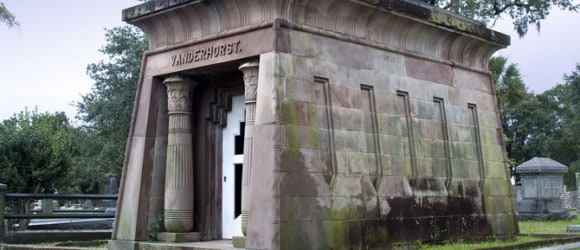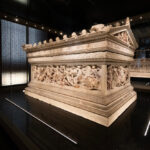Egyptian Revival Mausoleum: Mausoleum Styles and Architecture
- At March 20, 2013
- By Doug Keister
- In Doug Keister's Blog
 0
0

Egyptian is the most funerary style of architecture. After all, almost all architecture in ancient Egypt related to death and the afterlife.
American cemeteries trump American cities in their display of Egyptial architecture. While there is no denying that Egyptian Revival architecture is jam-packed with funerary symbolism, its obvious pagan origins reduces its popularity with the Christian community. Cemetery explorers find fewer and fewer examples of Egyptian Revival architecture the closer they get to the Bible Belt. However, those of the Jewish faith generally accept Egyptian architecture as much of their religious history is rooted in that region.
Egyptian Revival architecture is the easiest architecture style to identify, with pyramids particularly obvious. Almost every Egyptian Revival tomb is adorned with a pair of vulture wings (symbolizing protection and maternal care) sprouting from a circle (symbolizing the sun) and flanked by twin cobras (symbolizing death). Often a pair of sphinxes (male sphinxes are Egyptian; female sphinxes are Greek) guard the entry to the tomb. Above the tomb entry, and usually circling the entire tomb, is an architectural element called a cavetto cornice (flared with curve). Other hallmarks of Egyptian Revival architecture are the tapered (battered) entry and hieroglyphics. Since Egyptian architecture doesn’t make use of the strength of arches or tapering columns, its dimensions are quite massive. To provide strength, the walls of the Egyptian temple-style mausoleums taper in at about 70 degrees.
With their sleek style and long history, Egyptian mausoleums are visually pleasing, and their modest use of ornament makes them relatively maintenence free.
Another popular form of Egyptian architecture in the cemetery is the obelisk, representative of a ray of sunlight. Obelisks were first seen in Egypt during the time of the Old Kingdom, approximately 2650–2134 B.C. The earliest excavation of an obelisk, dated around 2500 B.C., is at Abu Ghurob. It was a massive, fairly squat, pyramidal structure set upon a high plinth and was the focal point of the sun temple. During the time of the Middle Kingdom, approximately 2040–1640 B.C., obelisks made of single slabs of Aswan granite became much taller and slimmer. They were typically erected in pairs in front of selected temples as part of a Royal Jubilee celebration. The sides of the obelisk were often inscribed, and the pyramidal top was sheathed in gold to radiate the light of the sun.
Designers of Egyptian Revival tombs often add selected Christian symbols to the tomb to soften the pagan demeanor. Statues of angels, Jesus, and the Virgin Mary are found guarding the entrance to these tombs.
Text and photo © Douglas Keister Visit Doug’s Author Page
[Douglas Keister Visit Doug’s Author Page] Google+
